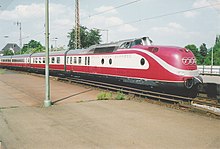Power end


A powered end car is an asymmetrical locomotive with only one driver's cab and which is always coupled to the train . In certain cases, locomotives that are only used in push-pull trains are also referred to as power cars.
use
Power cars are usually used when the drive is to be concentrated in separate vehicles at the ends of the train , in contrast to those multiple units where the drive is distributed over the entire train. From a technical point of view, power cars are locomotives with only one (complete) driver's cab and possibly only a reduced number of pulling and buffing devices on one side. On the train side, they often have an adapted transition to the adjoining car , which ensures a uniform appearance and better aerodynamics.
Typical representatives of multiple units with power heads are the German TEA - class VT 11.5 or 601 and the ICE 1 and the Italian ETR 500 using . The Eurostar Original, E300 and motorail trains in the Eurotunnel are also hauled by power cars . If a multiple unit has only one powered end car, there is usually a control car on the other side . Examples of this are the ICE 2 operated by Deutsche Bahn and the ET 4010 operated by ÖBB .
Examples of a powered end car on a push-pull train are the double-decker shuttle trains (DPZ) of the Zurich S-Bahn and the Italian E.464 . The difference here is that the intermediate wagons can also be used as normal trailer wagons in pulled trains (i.e. in trains without a control car).
disadvantage
Critics claim that the use of power cars combines the disadvantages of railcars and locomotive-hauled trains. On the one hand, such a multiple unit, like a multiple unit, can only be used in a fixed configuration, which makes flexible adaptation to fluctuating demand impossible (however, nowadays locomotive-hauled trains always run in the same association for maintenance reasons, for example at Deutsche Bahn as part of the program RIGA ). On the other hand, the power cars, like the locomotives, have a high axle load, which makes it necessary to equip the line accordingly, especially at high speeds. In addition, there is no space for seating in the power cars.
advantages
However, power cars can also be useful, for example if there is no more space for the drive units in double-decker cars . The drive noises also do not penetrate the passenger compartment. In newer series of the TGV , for example the TGV Duplex , the drive is now completely in the power end, while in the first series the first car behind the power end also had a powered bogie.
Web links
- bahn-seminar.info: Rules - Technical Terms - Explanations , accessed on April 4, 2016
Individual evidence
- ^ Andreas Steimel: Electric traction vehicles and their energy supply . 2nd Edition. Oldenbourg, Munich 2006, ISBN 978-3-8356-3090-1 , pp. 45 .
- ^ Raimo Gareis: German diesel traction vehicles from yesterday . 1st edition. Krone, Leichlingen 2001, ISBN 3-933241-36-7 , p. 137 .
- ^ Klaus Eckert: The big book of the locomotives . 2nd Edition. DuMont monte, Cologne 2002, ISBN 3-8320-8676-5 , p. 288 ff .
- ↑ Klaus Eckert, op. Cit. , P. 300
- ↑ LokMagazin 3/2016, p. 74

